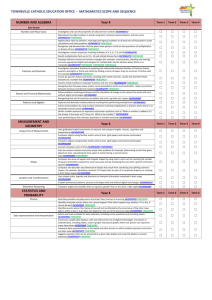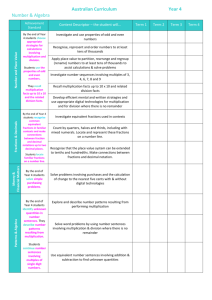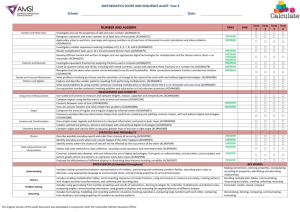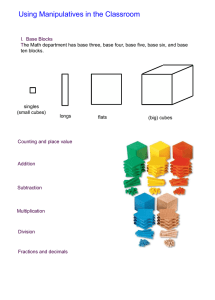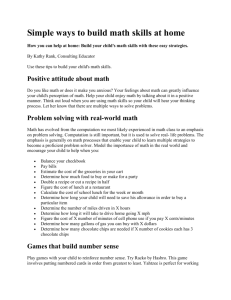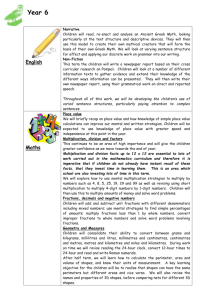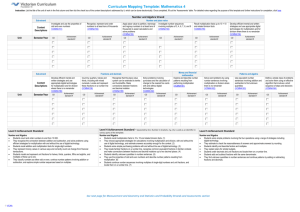69.5 KB - K-10 Outline
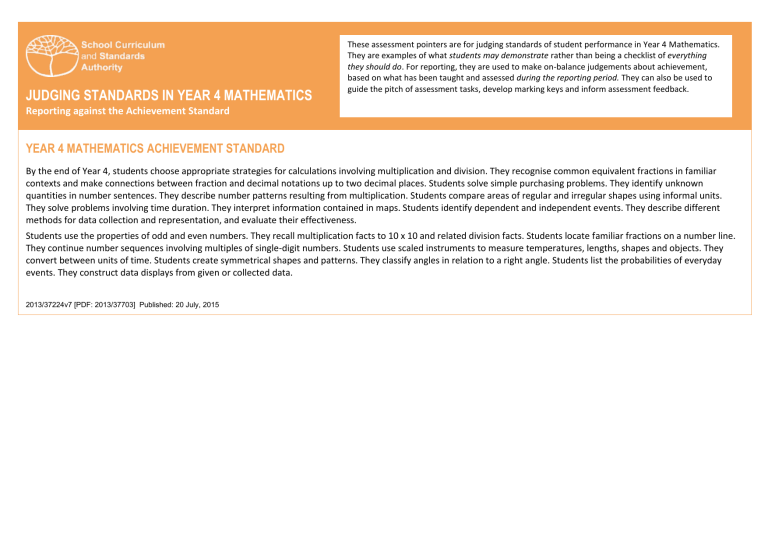
JUDGING STANDARDS IN YEAR 4 MATHEMATICS
Reporting against the Achievement Standard
These assessment pointers are for judging standards of student performance in Year 4 Mathematics.
They are examples of what students may demonstrate rather than being a checklist of everything
they should do. For reporting, they are used to make on-balance judgements about achievement, based on what has been taught and assessed during the reporting period. They can also be used to guide the pitch of assessment tasks, develop marking keys and inform assessment feedback.
YEAR 4 MATHEMATICS ACHIEVEMENT STANDARD
By the end of Year 4, students choose appropriate strategies for calculations involving multiplication and division. They recognise common equivalent fractions in familiar contexts and make connections between fraction and decimal notations up to two decimal places. Students solve simple purchasing problems. They identify unknown quantities in number sentences. They describe number patterns resulting from multiplication. Students compare areas of regular and irregular shapes using informal units.
They solve problems involving time duration. They interpret information contained in maps. Students identify dependent and independent events. They describe different methods for data collection and representation, and evaluate their effectiveness.
Students use the properties of odd and even numbers. They recall multiplication facts to 10 x 10 and related division facts. Students locate familiar fractions on a number line.
They continue number sequences involving multiples of single-digit numbers. Students use scaled instruments to measure temperatures, lengths, shapes and objects. They convert between units of time. Students create symmetrical shapes and patterns. They classify angles in relation to a right angle. Students list the probabilities of everyday events. They construct data displays from given or collected data.
2013/37224v7 [PDF: 2013/37703] Published: 20 July, 2015
YEAR 4 MATHEMATICS ASSESSMENT POINTERS
Number and Algebra
A
Excellent achievement
Represents and orders numbers beyond five digits and correctly writes them in words.
B
High achievement
Represents and orders five-digit numbers and correctly writes them in words.
C
Satisfactory achievement
Represents and orders five-digit numbers.
D
Limited achievement
Represents and orders numbers up to 10 000.
E
Very low achievement
Represents numbers up to
10 000.
Investigates the properties of odd and even numbers and solves problems involving any of the four operations. Uses the relationship of odd and even numbers to check accuracy.
Uses the properties of odd and even numbers to solve problems involving any of the four operations.
Uses the properties of odd and even numbers to explain why a number is odd or even.
Classifies numbers as odd or even.
Counts and groups collections of objects into twos.
Solves problems by identifying multiplication or division as the required operation and uses multiplication facts to 10 x 10 and related division facts.
Investigates and describes patterns in number sequences.
Solves problems using multiplication facts to 10 x 10, and related division facts.
Recalls multiplication facts to
10 x 10, and related division facts.
Recalls multiplication facts to
10 x 10, and counts through multiples to determine matching division facts.
Uses mental and written strategies to efficiently solve complex problems requiring at least two operations from multiplication and/or division without remainders, and uses related operations for checking.
Continues and describes number sequences involving multiples, e.g. 14, 28, 56.
Continues number sequences involving multiples of single-digit numbers, e.g. 7, 14. 21.
Continues simple increasing or decreasing number sequences based on multiples of 2, 3 or 5.
Identifies multiplication or division as the operation required and solves multiplication and division problems without remainders.
Uses related operations for checking, e.g. uses division to check multiplication.
Chooses appropriate strategies for calculations requiring multiplication or division without remainders, e.g. partitioning, place value and regrouping.
Uses materials to solve simple multiplication and division problems.
Uses repeated addition to determine multiplication facts.
Continues simple number sequences based on multiples of
2 or 5.
Represents multiplication and division by equal grouping and equal sharing.
Converts mixed numbers to improper fractions, and vice versa, and locates them on a number line.
Counts by quarters, halves and thirds, including mixed numerals, and locates them on a number line.
Locates familiar fractions on a number line, e.g.
1
2
,
1
3
,
1
4
,
1
6
,
1
8
.
Represents unit fractions as parts of a whole collection or shape, e.g. quarters, halves and thirds.
Models halves and quarters.
Number and Algebra
A
Excellent achievement
B
High achievement
C
Satisfactory achievement
Solves problems involving equivalence of fractions by using diagrams or drawings and writing the numerical relationship.
Investigates and compares fractions to prove equivalence in the same numerical relationship or represented by the same part of an object.
Identifies common equivalent fractions in familiar contexts, e.g. by folding or cutting paper to construct a fraction wall.
D
Limited achievement
Completes a visual representation of a given unit fraction, e.g. visual
1 representations of
2
,
1
4
.
E
Very low achievement
Divides collections and shapes into halves and quarters.
Uses place value to convert between mixed fractions, improper fractions and decimals, up to two places, e.g. writes 1
1
4
=
10
8
= 1.25.
Solves multi-step word problems involving purchases, selecting and applying a combination of operations and rounding change if necessary.
Calculates purchases in another currency.
Uses place value to convert between improper fractions and decimals, up to two places, e.g. writes
10
8
= 1.25.
Uses place value to make connections between fraction and decimal notations up to two decimal places, e.g. writes
6 6
10 as 0.6 and
100
as 0.06.
Identifies parts of a whole as a unit fraction and relates place value of decimals to tenths.
Solves two-step word problems involving purchases, e.g. calculates and compares unit prices. Rounds to the nearest five cents when calculating change.
Solves simple purchasing problems, e.g. When 8 stickers cost $4.00, how much does 1
sticker cost? Calculates change in dollars and cents.
Adds or subtracts money to calculate an amount. Calculates change in dollar amounts.
Identifies parts of a whole as a decimal.
Counts money by grouping notes and coins of the same denomination.
Creates and describes increasing and decreasing patterns in number sequences to satisfy a problem or rule, e.g. a number pattern showing doubling or halving.
Continues and describes patterns in increasing or decreasing number sequences involving multiples, e.g. continues 14, 28, 56 etc.
Investigates patterns in the number sequences, e.g. numbers that have 60 as a multiple.
Writes equivalent number expressions involving any of the four operations to find an unknown quantity, e.g.
? + 14 = 43 – 12.
Writes equivalent number sentences using partitioning to add and/or subtract to find an unknown quantity, e.g.
100 + 50 + 4 = 200 – ?
Describes number patterns resulting from multiplication, e.g. 1, 10, 100, 1000 etc.
Identifies unknown quantities in number sentences, e.g.
9 + ? = 24; 60 ÷ ? = 12.
Continues simple increasing or decreasing number patterns based on multiples of 2, 3 or 5.
Uses counting on or multiples to find a quantity.
Continues simple number patterns based on multiples of 2 or 5.
Counts a quantity.
Measurement and
Geometry
A
Excellent achievement
Measures and compares temperature, length, mass and capacity using scaled instruments, where not all graduations are shown.
B
High achievement
Measures and compares temperature, length, mass and capacity using scaled instruments.
C
Satisfactory achievement
Measures temperature, length, shapes (area) and objects
(volume and mass) using scaled instruments.
D
Limited achievement
Measures length using a metric ruler, and mass using direct comparison.
E
Very low achievement
Measures length using direct comparison.
Compares areas of regular and irregular shapes using familiar metric units of area to solve authentic problems, e.g. the floor plan of a house. Creates and describes composite shapes that result from combining or splitting common shapes.
Compares areas of regular and irregular shapes using familiar metric units of area, e.g. uses grid paper to count square units, making sense of part squares.
Compares shapes resulting from combining or splitting common shapes.
Compares areas of regular and irregular shapes using informal units, e.g. number of hands to cover a book and pencil case placed side by side.
Compares areas of regular shapes using informal units, e.g. number of hands to cover the top of the desk.
Solves multi-step problems involving time conversion and calculation of elapsed time, e.g. calculates travelling time when the departure and arrival times are given in am and pm notation.
Solves time problems to calculate an elapsed time in familiar contexts, e.g. calculates duration of swimming lesson from start and finish times.
Converts units of time in a range of equivalent units, e.g. the swimming lesson of 1
1
2
hours is 1 hour 30 minutes or 90 minutes.
Solves simple time problems involving duration, e.g. length of time spent at school. Converts between units of time.
Identifies the start and finish time of an event. Reads time to the nearest minute.
Interprets information and describes the differences in scales on maps to solve problems, e.g. compares distances represented on large-scale and small-scale maps.
Interprets information and simple scales contained in maps.
Interprets information contained in maps, e.g. legends, compass directions, landmarks.
Locates features on simple maps.
Compares areas using direct comparison, e.g. uses a sheet of newspaper to see what it can cover.
Reads time to the nearest quarter-hour.
Matches features on simple maps.
Creates and describes symmetrical designs for authentic purposes, e.g. motifs, textiles, art.
Creates symmetrical shapes, patterns and pictures with more than one line of symmetry.
Creates symmetrical shapes and patterns.
Continues symmetrical drawings or patterns.
Identifies symmetrical patterns in the environment, e.g. a window frame.
Measurement and
Geometry
A
Excellent achievement
Creates angles and compares them to a right angle using mathematical language, e.g.
acute, obtuse.
B
High achievement
Creates angles and compares them to a right angle.
C
Satisfactory achievement
Identifies a right angle and compares angles to a right angle, classifying them as equal to, greater than or less than a right angle.
D
Limited achievement
Identifies a right angle.
E
Very low achievement
Orders angles by size in familiar contexts, e.g. manipulates a model of an angle.
Statistics and Probability Predicts the likelihood and describes the outcome of an event, e.g. red is more likely to occur because there are more red segments on the spinner than other colours. Explains why an event is either dependent or independent.
Selects which of two events is the more likely to happen or whether chances are equal, e.g. identifies an equal chance of selecting a circle or square when there is the same number of each in a box.
Lists the probability of everyday events occurring from least likely to most likely. Identifies dependent and independent events.
Lists the possible outcomes of familiar events, e.g. rolling the die could result in a 1, 2, 3, 4, 5 or 6.
Selects and trials data collection methods, validating their effectiveness. Interprets a data display and generates questions to be answered by the display.
Constructs and validates suitable data displays from collected data.
Selects and justifies suitable data collection methods to complete an investigation, e.g. relevant survey questions.
Selects, constructs and justifies effective data displays.
Interprets data displays from a range of sources, e.g. school newsletter, newspaper.
Counts and tallies how many times an event occurs.
Describes and evaluates the effectiveness of various methods for data collection, e.g. counts, tallies, record sheets.
Describes and evaluates the effectiveness of various methods for data representation, e.g. tables, picture graphs, column graphs.
Constructs suitable data displays from given or collected data.
Describes various methods for data collection and representation and completes a data display.
With prompting, sorts and displays a set of data.
